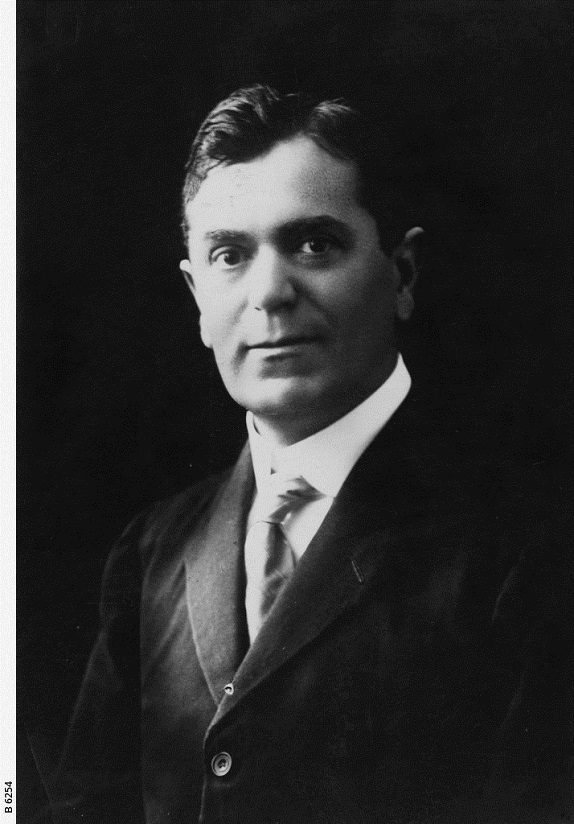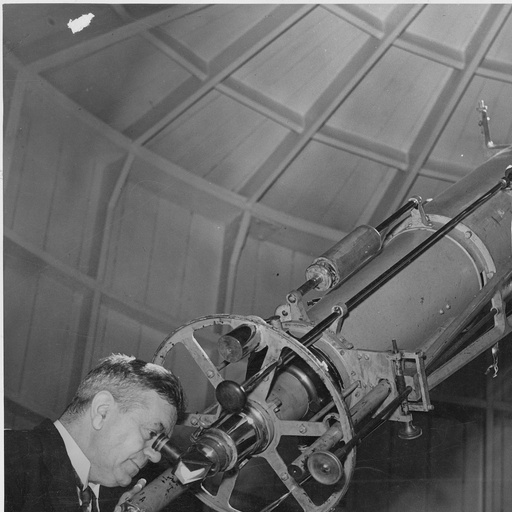Dodwell, George Frederick
One time resident of “Hillside” at Athelstone, George Frederick Dodwell was born in Leighton Buzzard, England, on February 13th, 1879 and died in Adelaide 10 August 1963, aged 84. He is buried at Nailsworth (North Road) Cemetery where his wife Annie Louisa Trehy who died in 1924 is also buried.

Photo: George Frederick Dodwell
Government Astronomer
The State Library of South Australia B 6254
He moved to Australia and attained his degree at Adelaide University and became a Fellow of the Royal Astronomical Society.
"He was appointed to the staff of the Adelaide Observatory on March 1, 1899, as a Junior Computor (the person who was responsible for the mathematical calculations) under Sir Charles Todd who had himself been trained under Sir George Airy at the Royal Observatory, Greenwich. He succeeded Sir Charles, being appointed Government Astronomer for South Australia in June 1909. Dodwell held this position until his retirement on October 31, 1952." 1
Wireless Telegraphy & Latitude Variations Research
George Dodwell’s notable achievements included fixing the boundary between South Australia and Western Australia using wireless telegraphy. He proposed that the boundary could be determined using wireless signals heard by Greenwich, Deakin and Argyle Downs simultaneously. The radio time signals were transmitted from Bordeaux, Lyon and Annapolis. This linked the Greenwich, Paris and Washington Observatories as well as those in Australia from April to July 1921. The project was the first time that the world had been measured from one side to the other using wireless telegraphy in conjunction with astronomical observation. 2
He also conducted a magnetic survey of South Australia. "This led on to his study of latitude variations which was held in conjunction with La Plata Observatory in Argentina, the International Latitude Congress and the International Astronomical Association. In September of 1922 he led a combined party with Sir Kerr Grant of Adelaide University to observe and photograph the total solar eclipse from Cordillo Downs, Australia, to test Einstein’s theory of the effect of gravitation on light." 3
"The study of latitude variations led George Dodwell to investigate the Obliquity of the Ecliptic (the tilt of the earth’s axis). This work commenced in 1934, a year after his uncle, Sir Frank Dyson, K.B.E., F.R.S., had retired as Astronomer Royal in England. An ancient manuscript by a Medieval Belgian astronomer Godefroid Wendelin, containing observations of the Obliquity, was published in 1933 and was obtained by Dodwell. The entire data set revealed a progressive and one-sided abnormality compared with Newcomb’s Formula.”4
“He concluded that there was consistent evidence that the tilt of the earth’s rotational axis was altered around 2345 BC. This view supported those that have claimed that the poles shifted within the memory of man, possibly as a result of a close encounter or impact with an extra-terrestrial body such as a comet. Some have gone further and attribute the destruction of Atlantis to this clash5.”
“Dodwell, a devout Christian, concluded that it was this sudden shift of the earth’s axis that led to the Flood of Noah.”6

Photo: The Observatory, State Library of South Australia B10172
The Karoonda Meteorite
The Karoonda meteorite fell to earth 3.6km away from the South Australian town of Karoonda at 10.53 pm on 25 November, 1930. The largest piece weighed 7lbs (3.2 kg), but the total of all fragments came to 92 lbs (41.73kg). It shook the town of Karoonda when it came crashing to earth leaving a crater 46 cm deep and about 2 feet in diameter8.
Dodwell was part of Professor Kerr Grant's party from the University of Adelaide, that located the Meteorite nearly a month later.
Photographs of the fragments of this meteorite can be view online at the Arizona State University website, and also on the District Council of Karoonda East Murray website.
The Dodwell Observatory
Mr Dodwell served as SA Government Astronomer from 1909 until his retirement in 1952 when the State Observatory was demolished and the time signal and other services were taken over by the Commonwealth Observatory at Mt Stromlo. The work of the SA observatory is commemorated by a plaque on the site of the old observatory on West Tce9.
The Observatory in Arkaroola, South Australia is named the Dodwell Observatory after George Frederick Dodwell.7
Researched and written by Sue Polkinghorne & Vaughan Williams, volunteers with the Campbelltown Library “Digital Diggers” group.
If you have any comments or questions regarding the information in this local history article, please contact the Local History officer on 8366 9357 or hthiselton@campbelltown.sa.gov.au
References
- Dodwell Manuscript, viewed 21 April, 2016
- Dodwell Manuscript, viewed 21 April, 2016
- Dodwell Manuscript, viewed 21 April, 2016
- Dodwell Manuscript, viewed 21 April, 2016
- Dodwell’s surprising study of the obliquity of the ecliptic | Tall bloke’s Talkshop, viewed 21 April, 2016,(https://tallbloke.wordpress.com/2014/12/24/dodwells-surprising-study-of-the-obliquity-of-the-ecliptic)
- Dodwell’s surprising study of the obliquity of the ecliptic | Tall bloke’s Talkshop, viewed 21 April, 2016, (https://tallbloke.wordpress.com/2014/12/24/dodwells-surprising-study-of-the-obliquity-of-the-ecliptic)
- Arkaroola Wilderness Sanctuary, viewed on 16 May, 2022, (https://www.arkaroola.com.au/astronomy-tours)
- District Council of Karoondah East Murray, viewed on 16 May, 2022 (https://www.dckem.sa.gov.au/discover/places-items-of-interest/karoonda-meterorite).
- SAO/NASA Astrophysics Data System (ADS), viewed on 21 April, 2016 (http://adsabs.harvard.edu/abstract_service.html)
Photo References
- George Frederick Dodwell, State Library of South Australia B 6254
- The Observatory, State Library of South Australia B 10172
